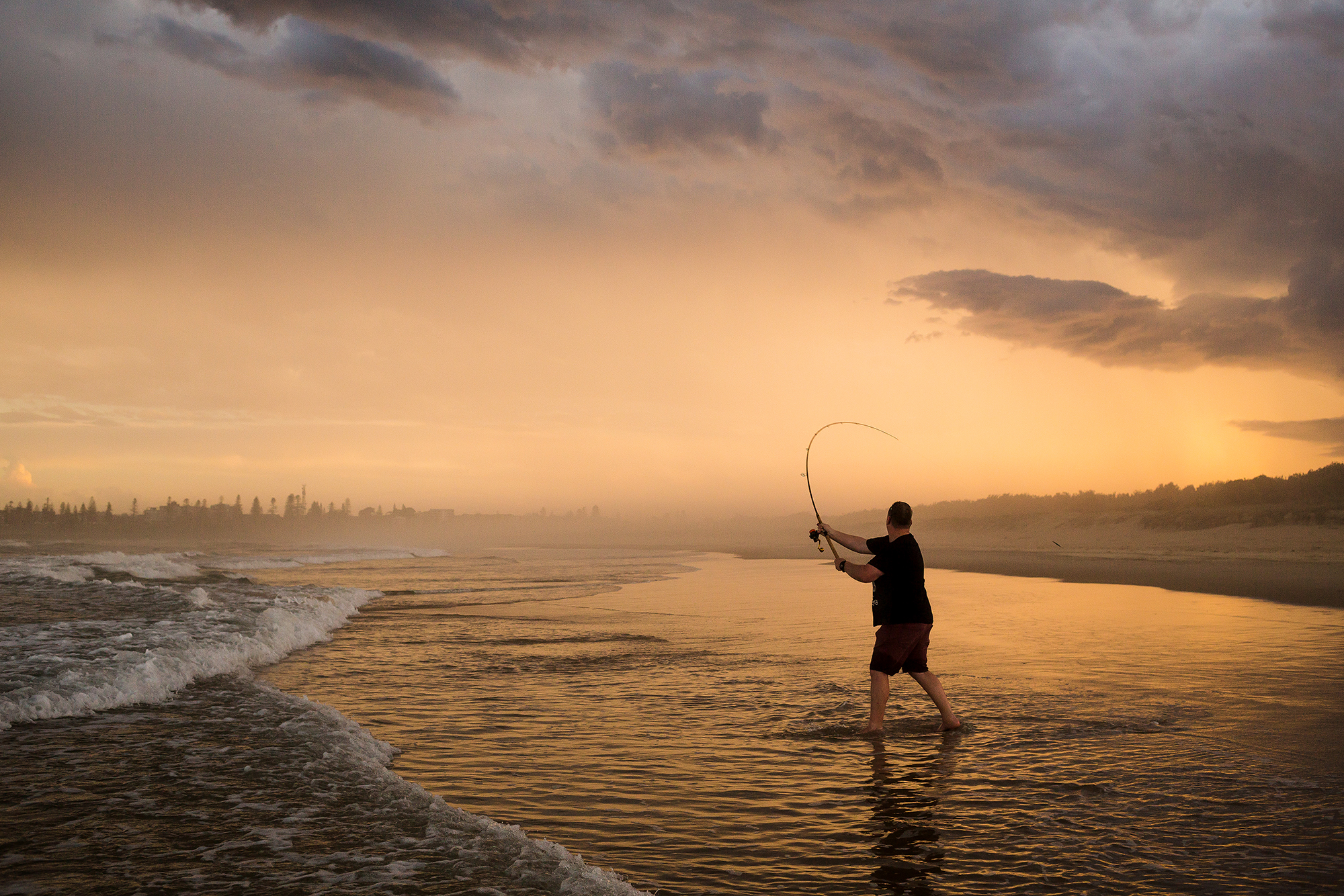
CASTING lures from the beach is hard to beat. It’s a bare bones form of fishing, often only requiring rod, reel and a few lures. It’s also a great way to get some exercise. Though, if catching a lot of fish is the primary objective, it’s not always the best option and there’s no question that fresh bait gets more bites on the beach.
That said, fishing with bait isn’t always practical. Bait collection and preparation can be time consuming. Getting bogged down with buckets and excess tackle also eats into precious fishing time. Additionally, beaches and gutters are constantly changing and the fish are very transient with the conditions. These factors can make it difficult to plan a successful trip well in advance.
On the flip side, hitting the sand for a couple of hours with a spinning rod and a few different lures is about as quick and clean as fishing can get. With little gear and preparation necessary, you can be casting a lure into the action in a matter of minutes after pulling up at a beach. Or if the conditions aren’t right, you can quickly change plans and do something else – without fear of that smelly bucket of bait cooking in the car!
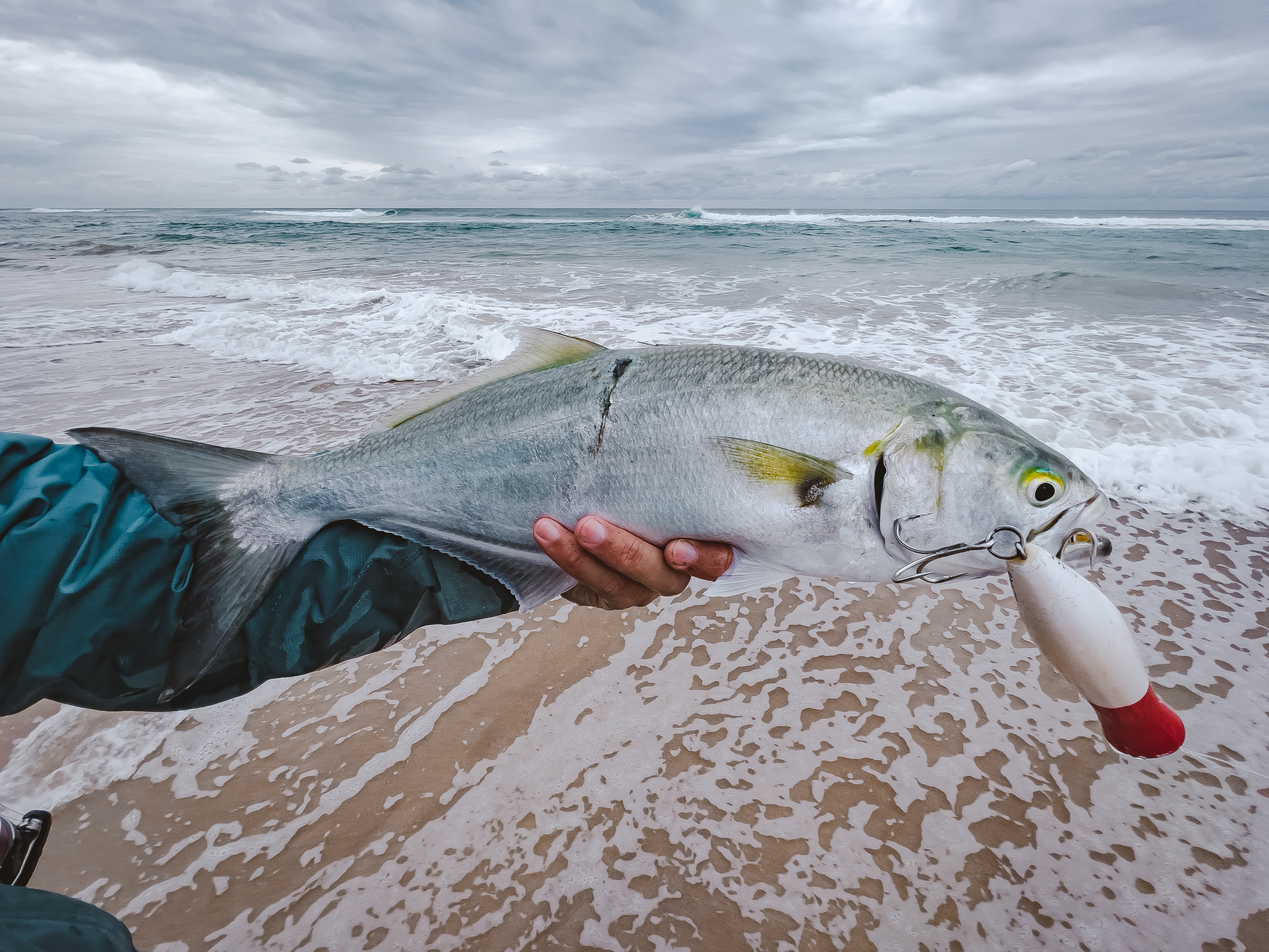
Why spring?
Spring is a great time for surf spinning. More consistent high pressure wind swells and less damaging, low pressure systems allow the beaches to form extensive gutter networks. The water temperature at this time of year is about as cool as it gets along the NSW coast, producing a mix of species. For anglers, all of the main targets along the beach are on offer. The typical “bread and butter” beach species: tailor, salmon, mulloway, flathead and bream. In this article, we’ll concentrate on how to go about best catching them on lures.
Tailor & salmon
Tailor and salmon are both schooling pelagic species that form the staple of surf spinning. For this article’s sake, I have grouped them together, though, they are quite different in reality.
Where I live, on the Mid North Coast of NSW, tailor are, at times, prolific. But for the better class of fish, upwards of 50-centimetres, there tends to be specific conditions that produce the “greenbacks” the area is known for.
Greenbacks love the “wash zone” and hunt aggressively in turbulent water. When there is small swell and little wash, tailor can become coy – especially towards lures. The ideal conditions for spinning up big tailor along the beaches around my neck of the woods is a medium swell (about 0.8m – 1.5m) and a light-to-moderate onshore wind. Effort with lures should be concentrated in the gutters or around the wash line, always looking for rolling waves and wash spilling over a deeper section or area of darker, calmer “green” water.
In contrast, some of my best sessions spinning up salmon have been in clear, calm offshore wind conditions. Australian salmon like to school behind the breakers or behind the outside bank of a gutter. They seem less reliant on using the wash to feed along the beach and rely more on a sheer abundance of bait. This can make them fussy lure eaters when they have dialed-in to a particular baitfish, like whitebait. It can take a few lure changes to figure them out!
The most practical and effective lure on the beach for both species are usually metal lures. Metals from 20 to 80-grams will outcast most other lures on a light spinning outfit and are easy to use. Though, for big tailor and salmon in particular, I like using medium size poppers, divers, plugs and stickbaits. Using larger lures is a great way to weed out the smaller fish and tempt the bigger models with a proper feed. The Halco Roosta 135 popper in particular is a proven performer for me on big surf tailor.
Dawn and dusk are generally preferred for both species, but it isn’t critical. Likewise, the tide phase isn’t all that important. Especially if the conditions are favourable and there is plenty of baitfish present.
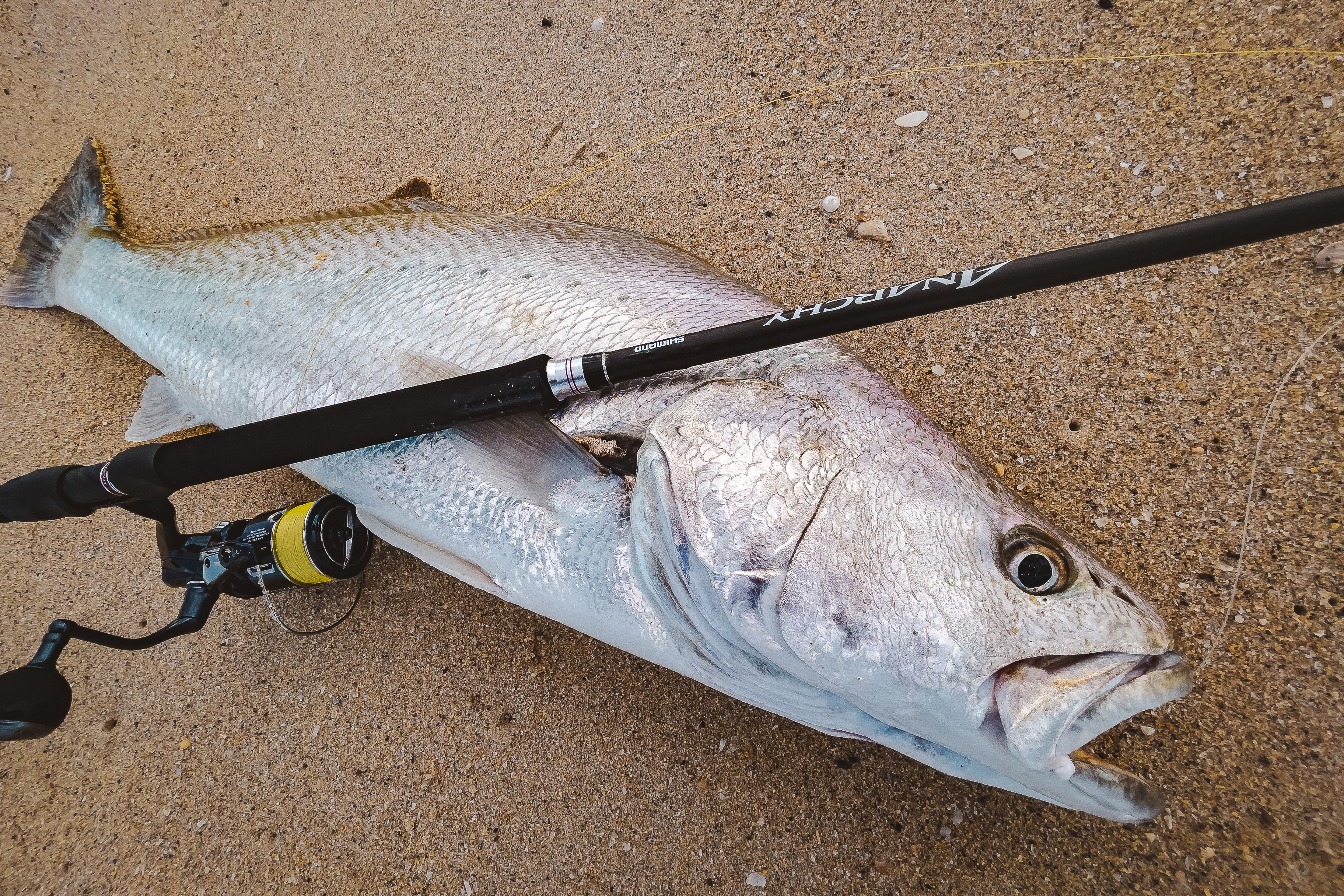
Mulloway
Targeting mulloway off the beach on lure during daylight hours is probably one of the most difficult ways of catching the species. But it is, in my mind, the most rewarding and enjoyable. It is important to remind yourself that you’re not going to catch them every session. But with a little effort and persistence, the fish will come eventually.
Much like tailor, mulloway also love the “wash zone”. In fact, many of the more promising looking “mulloway gutters” often turn up good catches of big tailor. The ideal scenario for targeting mulloway on lures from the beach is a gutter close to the shore, with a layer of whitewater/wash pushing over a deeper channel, hole or gutter of green water that allows easy entry and exit. This creates cover for mulloway to school, rest and ambush baitfish. Again, similar to chasing big tailor, I prefer a light-to-moderate onshore wind when chasing jewies on the sand, this tends to provide additional chop and wash. Generally speaking, fishing the higher tides for mulloway is preferred. These tides allow mulloway ample room to swim over the outside, shallower bank of the beach and along a gutter. Though, I have caught plenty of fish at low tide, too. It really does depend on the beach, conditions and gutter on the day.
Once you find them, mulloway generally aren’t too fussy along the beach. They will take soft plastics, hardbodys, metal lures and have even been caught on surface poppers! That said, there is no doubt that soft plastics are the best lure option for surf jewies. My “go to” lure is a 5 to 6-inch soft plastic rigged on a ½ to 1-ounce jighead. This combination allows excellent casting distance on 20lb braid, but isn’t too heavy, which compromises lure action. A mix of retrieves will catch mulloway on plastics off the beach. But a lift-and-drop action or a slow roll is often all that is required. A lot of the time, it’s just a matter of putting the lure in front of the fish. Plenty of times, I have had them eat the lure on the drop, just after it has landed in the wash.
The mulloway you’re likely to encounter along NSW beaches in spring are mostly “schoolies”, with the odd metre fish in the mix. Though, the “mystique of mulloway” means you can never be too sure when that genuine 20 kilogram fish might show up. Big jewies have a penchant for hunting in shallow, washy waters.
Be prepared to go through some soft plastics fishing for jewies along the beach, tailor tear them to pieces. To mitigate this, try fishing deep and slow. Though, some days, there’s no escaping them.
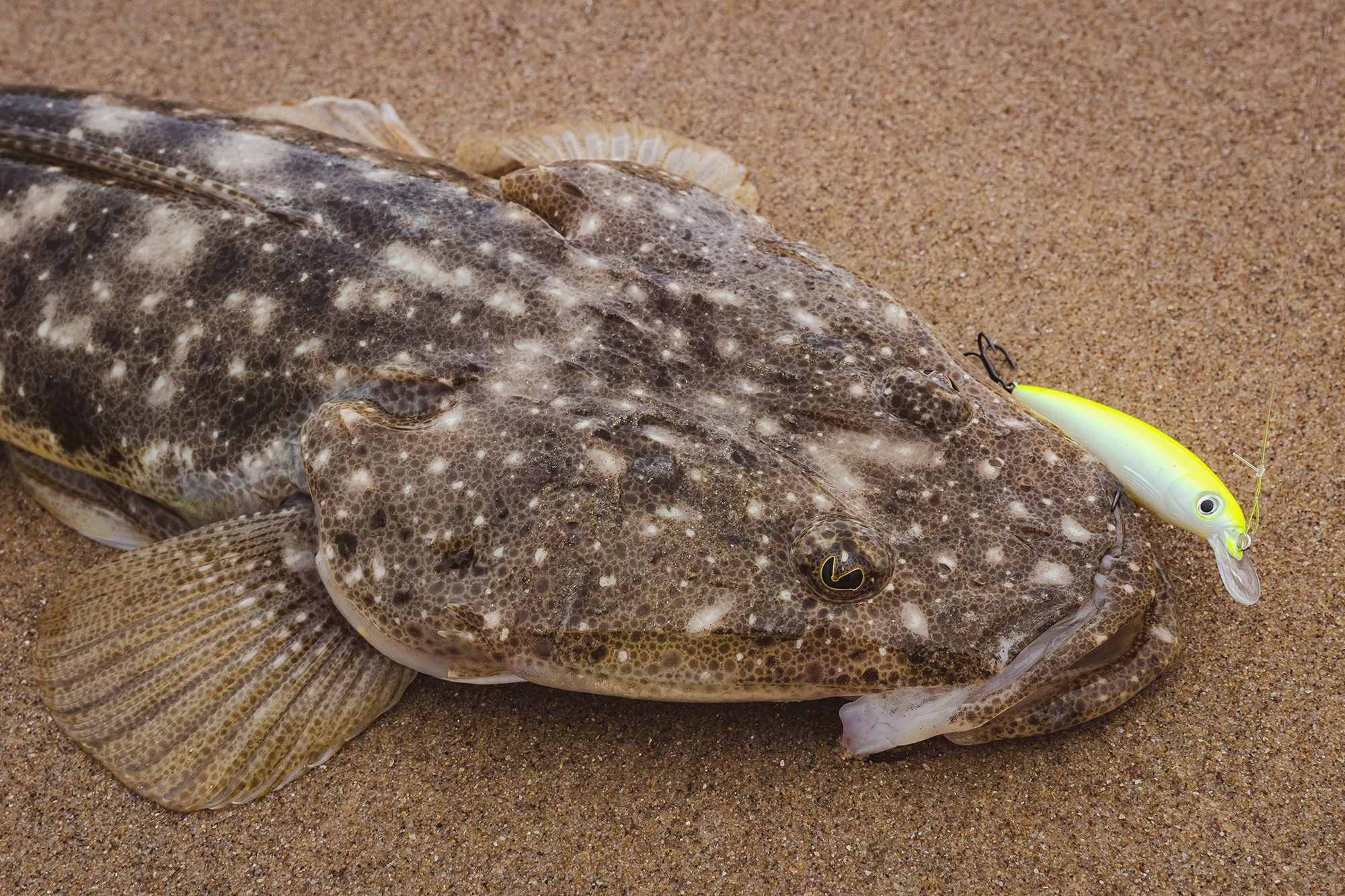
Flathead & bream
Bigger flathead are a common bycatch when targeting jewies off the beach on plastics. Good catches of big dusky flathead can come in late spring and autumn along the beaches. But if you specifically target them on smaller, 3 to 5-inch plastics, you will catch plenty of smaller table fish, too.
For flathead along the beaches, calmer conditions and the sheltered ends of beaches, where structure like scattered rocks, boulders and bombies lie tend to be the best. These areas also allow you to use a lighter “estuary” outfit to fish lures more effectively than a longer beach setup. The same estuary outfit can be used to cast 2-4 inch plastics and hardbody lures for bream, too. Effort should be concentrated along shallow gutters on an incoming tide for both species. If it is calm enough, small deep-diving crankbaits become deadly for both bream and flathead in these areas. Other fish like luderick, chopper tailor, pike and dart are common bycatch at times, too.
Several other lures like soft vibes, blades and deep diving jerkbaits are also effective along the beach. Interestingly, in the turbulent beach environment, both bream and flathead become far more aggressive towards lures. Don’t be surprised to catch some “stud” bream fishing the beaches with lures!
For the smaller soft plastics, you can get away fishing slightly heavier jighead sizes than in the estuary. For bream and 2-4 inch plastics, 1/10 to ⅙-ounce jigheads will allow a decent cast and a less wave affected retrieve. For flathead and 3 to 5-inch plastics, jigheads from ¼ to ½-ounce are preferred, depending on wave turbulence.
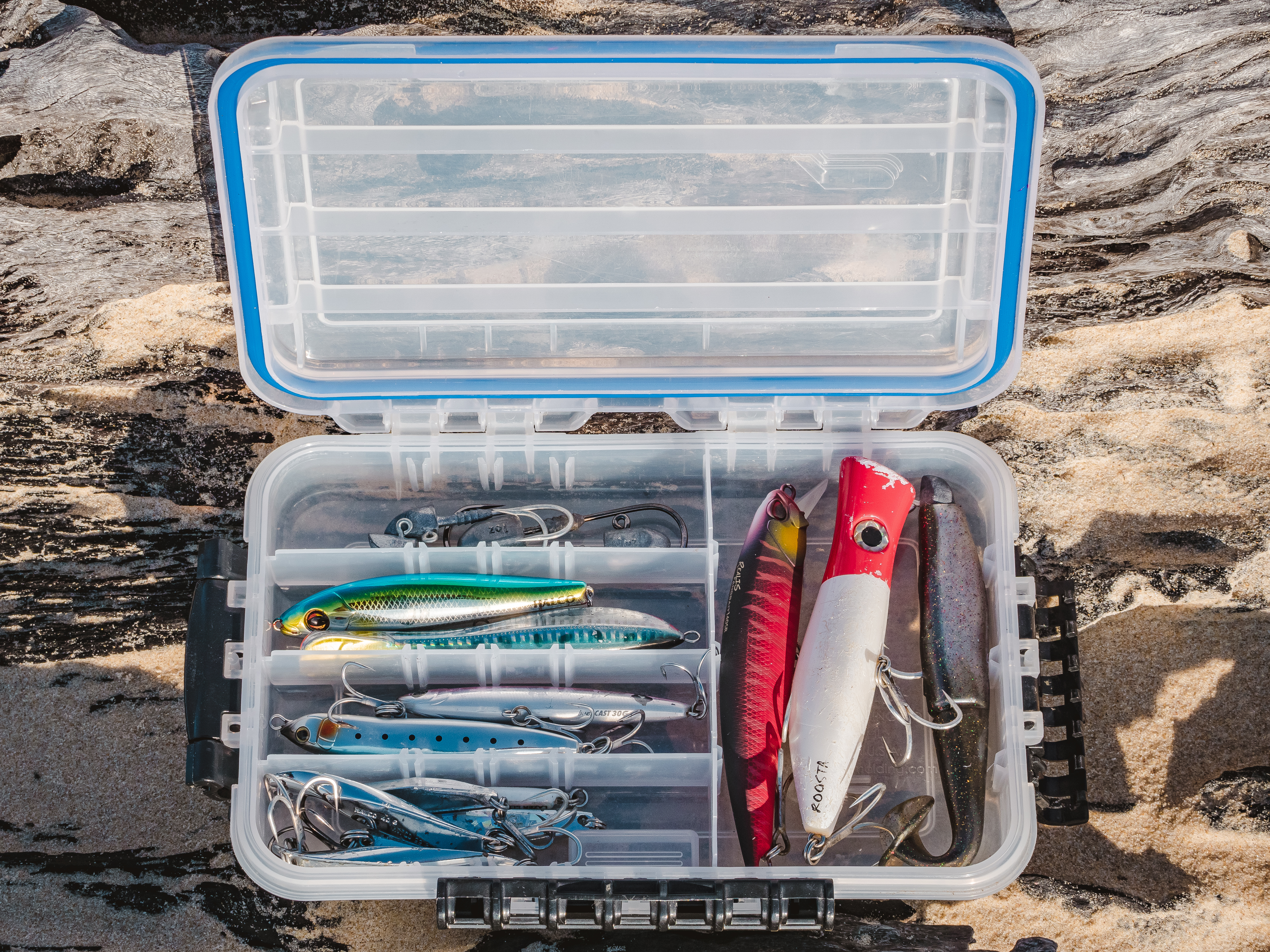
Surf spinning tackle
Ideally, for the above species, two outfits are preferred. One light-to-medium tackle surf spinning outfit suitable for tailor, salmon and mulloway and the other a light, “estuary” outfit that can double as a light surf combo for flathead and bream.
It’s important to consider buying the best reel you can afford for beach spinning, salt mist and sand is unavoidable. A sealed, saltwater specific reel will last a lot longer than a cheap reel. After every beach session, I like to give my gear a light spray with an atomiser spray bottle with a diluted Salt-Away solution.
Tailor, salmon and mulloway outfit
* 8’6 to 10-foot, 6 to 12-kilogram graphite rod
* 4000 to 5000-size spinning reel
* 20-lb braid mainline
* 20-40lb fluorocarbon leader (heavier leader may be required depending on class of fish, terrain and conditions)
Noteworthy beach lures:
* Tailor and salmon: Halco Twisty 20-70 grams, Halco Roosta 135, Bassday BungyCast
* Mulloway: 150mm Squidgy Fish with ⅝-ounce jighead, 6.2-inch Daiwa BaitJunkie Minnow with 1-ounce jighead
Flathead and bream outfit
* 7 to 8-foot, “flats style” 2 to 6-kilogram graphite rod
* 2000 to 3000-size spinning reel
* 6 to 8-lb braid mainline
* 8 to 12-lb fluorocarbon leader
Noteworthy beach lures:
* Flathead: 100mm Squidgy Fish with ⅜-ounce jighead, 80mm Squidgy Prawn Paddle Tail with ¼-ounce jighead
* Bream: Atomic Hardz 38mm Deep Crankbait, Squidgy 65mm Bio Tough Grub with 1/10-ounce jighead, Gulp! Crabby 2-inch with ⅛-ounce jighead.
Hopefully, it’s clear to see the benefits of actively fishing the beach with lures. Not only is it an enjoyable and simple way to fish, it’s a great way to fast track the learning curve of “reading a beach” and figuring out where different species like to forage.
Patrick Linehan is a professional fishing guide at Castaway Estuary Fishing Charters based in Port Macquarie, NSW. Get in touch here: www.castawayfishing.com.au.
















